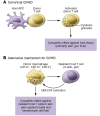Alternative mechanisms that mediate graft-versus-host disease in allogeneic hematopoietic cell transplants
- PMID: 32716364
- PMCID: PMC7456243
- DOI: 10.1172/JCI140064
Alternative mechanisms that mediate graft-versus-host disease in allogeneic hematopoietic cell transplants
Abstract
Allogeneic hematopoietic cell transplantation (alloHCT) benefits increasing numbers of patients with otherwise lethal diseases. Graft-versus-host disease (GVHD), however, remains one of the most potentially life-threatening complications due to its own comorbidities and the side effects of its treatment. In this issue of the JCI, two groups have turned dogma on its head by providing evidence for alternative mechanisms of acute GVHD (aGVHD) in humans. The principle of donor T cell reactivity elicited by host antigen-presenting cells (APCs) expressing MHC-encoded major HLA disparities or expressing minor histocompatibility antigen (miHA) differences presented by identical HLA molecules remains intact. These reports, however, demonstrate that GVHD can additionally result from peripheral host T cells resident in skin and gut being stimulated against donor APCs in the form of monocyte-derived macrophages. Moreover, these donor monocyte-derived macrophages can themselves mediate cytopathic effects against resident host T cells in skin explants and against a keratinocyte-derived cell line.
Conflict of interest statement
Figures

Comment on
-
Donor monocyte-derived macrophages promote human acute graft-versus-host disease.J Clin Invest. 2020 Sep 1;130(9):4574-4586. doi: 10.1172/JCI133909. J Clin Invest. 2020. PMID: 32453711 Free PMC article.
-
Peripheral host T cells survive hematopoietic stem cell transplantation and promote graft-versus-host disease.J Clin Invest. 2020 Sep 1;130(9):4624-4636. doi: 10.1172/JCI129965. J Clin Invest. 2020. PMID: 32516138 Free PMC article. Clinical Trial.
References
-
- Barba P, et al. Ex vivo CD34+-selected T cell-depleted peripheral blood stem cell grafts for allogeneic hematopoietic stem cell transplantation in acute leukemia and myelodysplastic syndrome is associated with low incidence of acute and chronic graft-versus-host disease and high treatment response. Biol Blood Marrow Transplant. 2017;23(3):452–458. doi: 10.1016/j.bbmt.2016.12.633. - DOI - PMC - PubMed
Publication types
MeSH terms
Grants and funding
LinkOut - more resources
Full Text Sources
Research Materials
Miscellaneous

